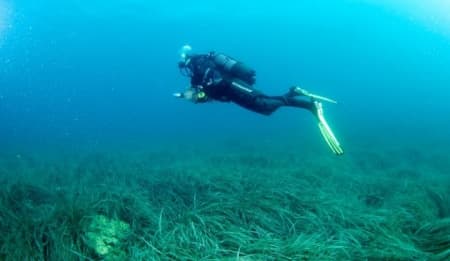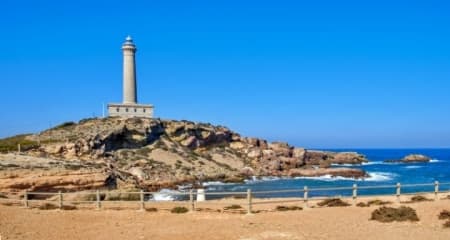
Cabo de Palos
Cabo de Palos has an exceptional position, closing the southern gate of the Mar Menor. A cape is a protrusion of land that, breaking the coastline, enters the sea, thereby creating a territorial space with particular geographical attractions.
From ancient times, it was called Cabo de Palos because of the resemblance of the Mar Menor to a large lagoon. Palos comes from palus, which means “lagoon” in Latin. Cabo de Palos is a coastal area made up of majestic coves, including La Galera cove, Botella cove, Avellan cove, Flores cove, and Tunez cove, distinguished by their transparent waters.
Diving in Cabo de Palos
Cabo de Palos is integrated into the Mar Menor Nautical Station in recognition of the excellent and safe conditions of its water, which enable the practising of water sports (particularly diving) throughout the year.
The important biodiversity present in this coastal area led to the creation of the Cabo de Palos and Hormigas Islands Marine Reserve. This marine reserve, one of the most important in the Mediterranean Sea, is the dream of many divers. From Cabo de Palos, the reserve begins on an impressive submerged mountain range, which extends over a territory of about 19 km² between Cabo de Palos and the Hormigas Islands. It offers one of the best diving areas, thanks to the large number of sunken ships and its impressive seabed, bestowing on it the title of best diving destination on the European continent.
The Cabo de Palos Lighthouse
This tower was demolished some time ago, and many of its carved stones were used in the construction of the current lighthouse, on which construction began in 1862. It was put into operation for the first time three years later. The tower is 51 meters high on the land where it was built and 81 meters above sea level.
The Cabo de Palos Lighthouse has a base that is 20 meters wide and 14 meters high.
In the center, on a pedestal, the tower rises in the form of a column that acquires elements of Tuscan order. There is also a capital with projections supporting a circular cornice with a sill that serves as a railing and that is crowned by a cylindrical tower housing the lantern.
In the center, on a pedestal, the tower rises in the form of a column that acquires elements of Tuscan order. There is also a capital with projections supporting a circular cornice with a sill that serves as a railing and that is crowned by a cylindrical tower housing the lantern.
The marina
It has a colorful fishing and sports port located in front of the Levante beach, made up of a thick breakwater built with stones joined with mortar and a counter-dam. Inside, a small dock is formed by five floating docks for small boats.This port offers access to the town of Cabo de Palos, administratively located in the Rincon de San Gines deputation, a subdivision of the municipality of Cartagena. This small center, inhabited by 1,026 inhabitants (2019 data), has an old part with beautiful streets flanked by small restaurants and bars located in the small houses that, long ago, formed the small fishing village of Cabo de Palos.
Cabo de Palos today
Today, Cabo de Palos is an enormous tourist attraction due to its incredible seabed and attractive beaches and coves, as well as its historic lighthouse and its wide Mediterranean gastronomic offerings —especially the cauldron of the Mar Menor, a dish made with local fish and rice.Very close to Cabo de Palos is the Calblanque, Monte de las Cenizas, and Peña del Aguila Regional Park, one of the best preserved natural spaces in the Mediterranean. It is practically virgin.















